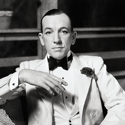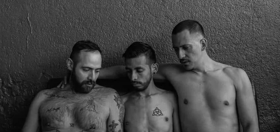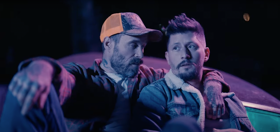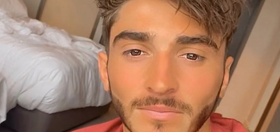To anyone who has ever wanted to leave their awkward body and become a bodybuilder, supermodel, celebrity, drag queen, stripper, historical figure, or cartoon character — for one day or the rest of their lives — gay multimedia Barry Morse empathizes. Ever since childhood he’s wanted to become everything he has ever found attractive. It’s an obsession that led him to striptease as a sexy Shirley Temple, take steroids to compete in body building, and undergo more than seven plastic surgeries to “fix” his face.
He posed as a muscular nude in his latest gallery showing (Narcississy), did a series of self-portraits costumed like iconic celebrities (The Morphing Man), and dressed as a leopard-thonged punk-rocker in his most recent short film, Mouse’s Birthday (which just screened at Outfest in LA). But while such eccentric work may seem intensely vain, dramatic, and even insane, Morse’s artwork explores the psychological aspects of self image, childhood, and media in a challenging and eclectic body of work at the forefront of contemporary queer art.

His four-minute film Mouse’s Birthday serves as a musical meditation on addiction that combines greenscreen, animation, silent film, animal costumes, and live-action along with a mock heroic children’s rhyme sung in a creepy discordant tune. In it, a greedy mouse gets squashed by the cake he craves, a womanizing cockroach gets stomped by the object of his affection, and a vainglorious punk-rocker gets gaybashed while admiring himself in the mirror. All three characters end up in a strange afterlife surrounded by dieties, demonic clowns, and musclemen flexing in leather masks.
Morse’s fairy tale film lives somewhere between Sesame Street and Nightmare on Elm Street. By exploring addiction, insecurity, and queer-bashing in playful, child-friendly mediums, he heightens and minimizes the seriousness of his subject matter and makes something that’s funny yet troubling, cute yet scary.
“I have this extreme fascination with childhood,” Morse tells Queerty. “As a child there’s no limits to your imagination, so it can be terrifying — the unknown. For example, the mask of the cockroach [in Mouse’s Birthday] was based on elementary school masks and New Guinea tribal masks. I mixed this historical tribal mask with the innocence and terrifying-ness of a child’s creation, which to me is more scary than anything that adults come up with because of it comes from a mind unable to render reality.”
He actually got the idea for the film while at a restaurant in Tel Aviv. Dressed in eye makeup, a mesh tank top, and a mohawk, Morse stood out from the conservative t-shirt and jeans of Israel’s military set. While checking out a group of “four of the most beautiful men [he] had ever seen,” Morse suddenly got an internal feeling of hatred from the group and became worried that they might even jump him. He acknowledges that he might have imagined it all, but he found it terrifying yet ironic that he had wanted their attention to begin with — a paradox which formed basis of his film.
It’s hard to pin down Mr. Morse’s style. He’s a child of Andy Warhol and John Waters, no doubt, who once paid homage to deceased queer video artist Tom “Pickle Surprise” Rubnitz by making his own dessert commercial for Ookie Cookie (referencing a fraternity game that involves competitive circle jerks and protein-drenched pastries). He’s playful but sophisticated, seemingly simple yet multi-layered, and turns pop-culture icons into modern archetypes that unfold before viewers like a phantasmagoric pop-up book.

In this age of personality cults and reality TV, Morse also blurs the line between art and artist. One of his projects involves snapping pictures of himself every week for several years to chronicle the transformation of aging. He also teamed up with photographer Martin Levinne to star in The Morphing Man, a series of photographs where Morse dressed up as instantly recognizable historical figures like Ghandi, Alice Cooper, Liza Minelli, Salvador Dali, Frieda Kahlo, and Gilligan from Gilligan’s Island.
Morse, who has worked as a licensed cosmetologist since 1998, sees body image and transformation as central to both his work and identity: “I think only positively about transformation because it never ends. As a hairdresser I don’t understand some people who want to have the same look every day, whereas some people want to constantly evolve and have instant change. [Critical people will say] ‘She changes her look so much. It just shows a sense of insecurity and she needs to grow up.’ But (changing your appearance) is an artistic statement. You’re creating an artistic expression with your body which for me is something to be put on a pedestal.” He adds, “I’m either cracked or sick or I have a deep appreciation for how people see themselves.”
You can get a DVD compilation of Barry Morse’s work at the Antebellum Gallery.


















L.
That is all quite weird, but at the same time, it was really cool. I enjoyed that. A departure from the usual Q. fare, but a good one.